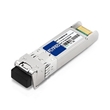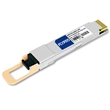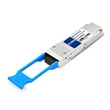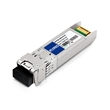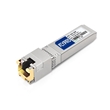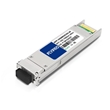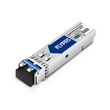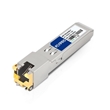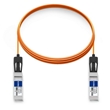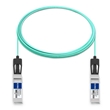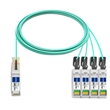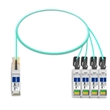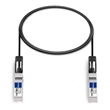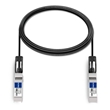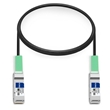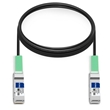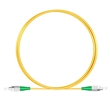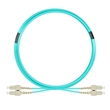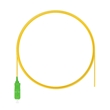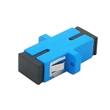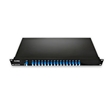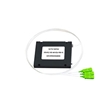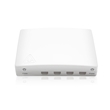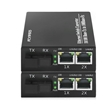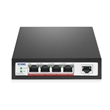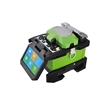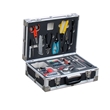Classification of SFP+ Optical Modules

- Introduction
- Introduction to SFP+ Optical Modules
- Packaging Type of SFP+ Optical Modules
- Classification by Transmission Distance of SFP+ Optical Modules
- Interface Classification of SFP+ Optical Modules
- Wavelengths of SFP+ Optical Modules
- Other Considerations
- Frequently Asked Questions(FAQs)
- Q1: Can SFP optical modules be inserted into devices or network cards with SFP+ ports?
- Q2: Can SFP+ optical modules be inserted into devices or network cards with SFP ports?
- Q3: How do you evaluate the performance differences of SFP+ modules from different manufacturers at specific transmission distances and wavelengths?
- Q4: When selecting SFP+ modules, why take into account typical receiver sensitivity and overload points? What impact do these parameters have on network design?
- Q5: In a dense data center environment, what considerations are there for the interference or crosstalk between SFP+ modules?
- Q6: When deploying active devices with SFP+ interfaces, how do you determine the maximum link loss that can be applied based on the type of fiber and connectors?
- Q7: How to ensure the thermal stability of the SFP+ modules and assess the impact of module operating temperature on transmission performance?
- Q8: How can you determine if an SFP+ module is fully compatible with a specific brand's network equipment?
- Q9: When selecting an SFP+ module provider, how should you evaluate their product quality and after-sales service?
- Q10: When setting up an optical network, is it more advantageous to purchase OEM SFP+ modules or to use third-party modules?
- Conclusion
- Contact Us
Introduction
With the rapid development of the network, the 10G Ethernet network will gradually replace the 1G Ethernet network. At the same time, SFP+ optical modules are extensively used in various network scenarios. This article will introduce the SFP+ optical modules from the perspectives of packaging type, transmission distance, interface, and wavelength.

Introduction to SFP+ Optical Modules
SFP+ optical modules are optoelectronic conversion modules with a transmission rate of 10Gbps, encapsulated in the SFP+ form factor, with LC or RJ45 interfaces, and their transmission distances typically range from 1M to 80KM. 10G SFP+ modules connected through LC or RJ45 interfaces are inserted into devices such as switches or servers to complete the conversion between optical and electrical signals. Due to their high transmission speed, compact packaging, hot-swappable functionality, low power design, variety of transmission distances, support for multiple wavelengths, diverse interfaces, and low electromagnetic interference emission, these modules have been widely applied in network applications such as data centers, storage systems, local area networks, and metropolitan area networks.
Packaging Type of SFP+ Optical Modules
SFP (Small Form-factor Pluggable) represents the packaging type of optical modules.
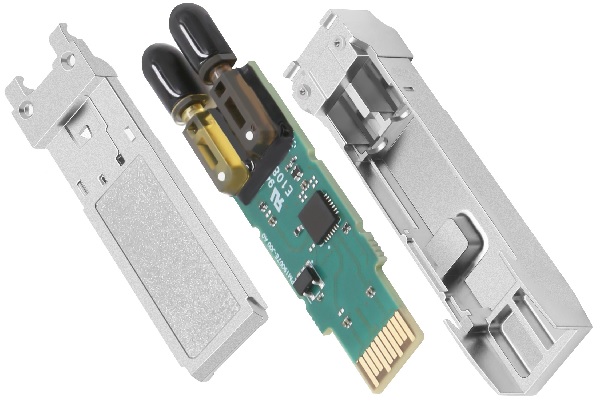
As the name suggests, SFP+ is an upgraded version of SFP. The appearance and size are very similar, but in actual use, these two packaging forms correspond to optical modules with different rates, and their performance and purposes vary greatly. SFP packaging corresponds to optical modules of 100M and 1G, while SFP+ corresponds to 10G optical modules.
In daily communication and use, some customers habitually write SFP+ modules as 10G SFP optical modules.
Classification by Transmission Distance of SFP+ Optical Modules
In SFP+ optical modules, types such as SR, LR, LRM, LRM2, LR, ER, and ZR are used to describe different types of optical modules according to applicable transmission distances and fiber types.
SR (Short Range)
Model:SFP-10G-SR
Transmission Distance:Suitable for short-distance transmission, compatible with OM3 multimode fiber (MMF) up to 300M, and OM4 multimode fiber (MMF) up to 400M.
Fiber Type:Multimode fiber (MMF), typical wavelength of 850nm, usually used with OM3 multimode fiber (MMF).
Features:Low cost and low power consumption.
Some vendors categorize 10G SR optical modules as 10G SRL, i.e., 10G SR lite, which are actually the same product.
LRM (Long Reach Multimode)
Model:SFP-10G-LRM
Transmission Distance:Suitable for short-distance, high-performance networks, compatible with OM multimode fiber (MMF) up to 220M and single-mode fiber (SMF) up to 300M.
Fiber Type:Multimode fiber (MMF), typical wavelength of 850nm, usually used with OM3 multimode fiber (MMF).
Features:High speed and good compatibility.
LRM2 (Long Reach Multimode 2)
Model:SFP-10G-LRM2
Transmission Distance:LRM2 is an upgraded version of LRM, suitable for long-distance, high-performance networks, up to 2KM.
Fiber Type:Multimode fiber (MMF) or single-mode fiber (SMF), typical wavelength of 1310nm.
Features:Extended transmission distance compared to LRM.
LR (Long Range)
Model:SFP-10G-LR
Transmission Distance:Suitable for long-distance transmission, up to 10KM.
Fiber Type:Single-mode fiber (SMF), typical wavelength of 1310nm, usually used with OS Single-mode fiber (SMF).
Features:Long distance and high speed.
ER (Extended Range)
Model:SFP-10G-ER
Transmission Distance:Used for long-distance transmission, suitable for inter-city network connections, up to 40KM.
Fiber Type:Single-mode fiber (SMF), typical wavelength of 1550nm, for further distance transmission.
Features:Even longer distances and high speed.
ZR
Model:SFP-10G-ZR
Transmission Distance:Used for ultra-long-distance transmission, up to 80KM, and some even further, reaching 100KM.
Fiber Type:Single-mode fiber (SMF), typical wavelength of 1550nm, often requires Dense Wavelength Division Multiplexing (DWDM) technology for long-distance data transmission.
Features:Ultra-long distance, high speed, and a wide operating temperature range.
The values listed above are the maximum under ideal conditions. In actual use, the transmission distance not only depends on the types of optical modules and fibers but also is affected by signal attenuation, device position, power, environmental factors (such as temperature, humidity), and whether there is electromagnetic interference along the transmission path. Therefore, in reality, the fibers matched with optical modules usually need a performance redundancy to improve the stability and transmission quality of the communication system.
Interface Classification of SFP+ Optical Modules
Currently, there are two common interfaces for SFP+ optical modules on the market: LC and RJ45.
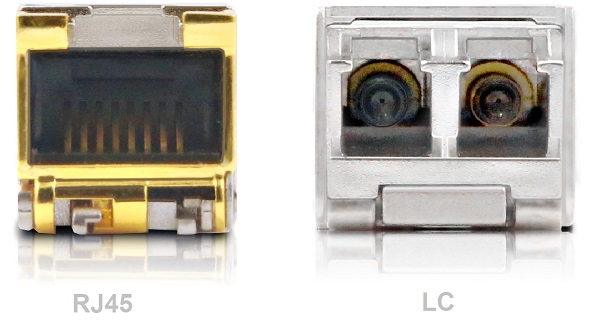
- LC
The previously mentioned SR, LR, LRM, LRM2, LR, ER, and ZR optical modules all use LC interfaces. High speed, long distance.
- RJ45
Optical modules with RJ45 interfaces are 10G electrical port optical modules, also known as 10GBASE-T Optical Modules. They are transmitted via copper cables, are cost-effective, and can seamlessly integrate with existing 1G networks for incremental upgrades.
- LC
Wavelengths of SFP+ Optical Modules
There are three conventional wavelengths for SFP+ optical modules: 850nm, 1310nm, and 1550nm.
- 850nm
Corresponds to the SR optical module mentioned above, suitable for interconnection within a local area network (LAN).
- 1310nm
Corresponds to LR, LRM, LRM2 optical modules mentioned above, suitable for larger-scale enterprise networks and metropolitan area networks.
- 1550nm
Corresponds to ER, ZR optical modules mentioned above, suitable for wide area networks (WAN) or service provider networks that span cities or even cross-country.
- 850nm
Other Considerations
Beyond these main categories, there are several other factors at play.
- Tunable Modules
Tunable modules allow for the selection of specific wavelengths, offering flexibility and being indispensable in DWWM networks.
- DWDM and CWDM Modules
To multiplex multiple wavelengths over the same fiber, 10G SFP+ transceivers come in Dense Wavelength Division Multiplexing (DWDM) and Coarse Wavelength Division Multiplexing (CWDM) variants, each suited for different channel spacings and distances.
- BiDi Modules
BiDi modules utilize Wavelength Division Multiplexing technology to transmit and receive signals on a single fiber. Therefore, they must be used in pairs. By tuning duplexers to match the desired wavelengths of transmitters and receivers, bidirectional data transmission is achieved. The biggest advantage of BiDi modules is that they cut the cost of fiber infrastructure in half, as they require fewer fibers, reducing the complexity of fiber wiring. BiDi modules are suitable for applications where there is a need to reduce the consumption of fiber resources. Although BiDi modules are more expensive than regular modules, the cost saved by using fewer fibers can greatly outweigh the increased purchasing price. For users with insufficient fiber resources, BiDi modules are a better choice.
- Tunable Modules
Frequently Asked Questions(FAQs)
Q1: Can SFP optical modules be inserted into devices or network cards with SFP+ ports?
A1: Yes, generally, SFP optical modules can be inserted into SFP+ ports. However, when an SFP module is inserted into an SFP+ port, because of their different performance and purposes, they are not fully compatible, and the port's speed will be limited to a lower rate. Additionally, not all devices with 10G ports can adapt to 1G; this depends on specific product manuals. Therefore, when choosing and using optical modules, ensure they are matched with the device's port speed to avoid performance degradation or compatibility issues.
Q2: Can SFP+ optical modules be inserted into devices or network cards with SFP ports?
A2: No, generally, SFP+ modules cannot be inserted into devices or network cards with SFP ports as SFP ports are not backward compatible with them.
Q3: How do you evaluate the performance differences of SFP+ modules from different manufacturers at specific transmission distances and wavelengths?
A3: Compare their minimum and maximum transmit power, receive sensitivity, and wavelength tolerance in the module's data sheet. Laboratory testing can be done using eye diagrams, Bit Error Rate (BER) testing, and spectral analysis to evaluate performance.
Q4: When selecting SFP+ modules, why take into account typical receiver sensitivity and overload points? What impact do these parameters have on network design?
A4: Receiver sensitivity refers to the minimum optical signal power that the module can detect, and the overload point indicates the maximum optical signal power that can be sustained without damage. In network design, these parameters determine the link budget and the transmission distance and must ensure that the link loss is within the module's tolerance.
Q5: In a dense data center environment, what considerations are there for the interference or crosstalk between SFP+ modules?
A5: When designing a dense data center, factors like circuit board design, signal integrity, and shielding must be considered to reduce crosstalk. Manufacturers will specify shielding requirements and minimum spacing to ensure signal quality. Port dividers or increasing spacing can be used to further reduce interference.
Q6: When deploying active devices with SFP+ interfaces, how do you determine the maximum link loss that can be applied based on the type of fiber and connectors?
A6: The maximum link loss depends on the optical power budget of the SFP+ module, which includes the difference between the transmit power and the receive sensitivity, considering losses from connectors, splices, and the fiber itself. During deployment, an optical power meter and Optical Time Domain Reflectometer (OTDR) can be used to measure actual loss to ensure that it falls within the prescribed optical power budget.
Q7: How to ensure the thermal stability of the SFP+ modules and assess the impact of module operating temperature on transmission performance?
A7: Ensure that the SFP+ modules meet industrial or commercial-grade temperature specifications and operate within the specified temperature range. Temperature monitoring and periodic maintenance checks can be employed to ensure stability. High temperatures can cause a reduction in laser output power and deterioration of signal quality.
Q8: How can you determine if an SFP+ module is fully compatible with a specific brand's network equipment?
A8: The most reliable method is through the equipment manufacturer's compatibility list or by confirming the optical module's encoding compatibility with the specific brand's equipment through third parties. Field testing can also be conducted for functional verification.
Q9: When selecting an SFP+ module provider, how should you evaluate their product quality and after-sales service?
A9: Check the supplier's market reputation, product quality certifications (such as ISO standards), customer feedback, and after-sales service commitments. Request for case studies and test reports and review their return and exchange policy.
Q10: When setting up an optical network, is it more advantageous to purchase OEM SFP+ modules or to use third-party modules?
A10: Third-party modules are usually less costly than OEM modules, and many third-party suppliers’ modules are also compatible with various brands' equipment, providing guarantees and technical support. When choosing, ensure that the third-party modules' quality and service can meet business requirements.
Conclusion
Choosing the right SFP+ optical module requires consideration of network performance requirements, transmission distance, fiber type, wavelength needs, and compatibility with existing equipment. Overall, SFP+ modules are an efficient, flexible solution and have become a crucial member of the modern data communication infrastructure.
Contact Us
If you have any further questions or require more specific information, feel free to ask! info@flypro.com


